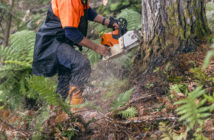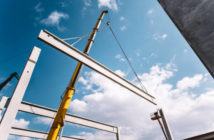Accidents and emergencies can occur at any time and a quick response may mean the difference between life and death – as Bob McGuiness’ workmates found out first hand.
It seemed like a normal day at work, but things quickly took a dramatic turn for the Fletcher team when their workmate Bob suddenly collapsed.
Bob was preparing to lift some steel when he fell to the ground, suffering a heart attack. Luckily, his colleagues knew how to respond.
An AED was retrieved from the shed nearby, the ambulance was called and several workers provided first aid and treatment. Bob’s workmates gave CPR and attached the AED, and a shock was given.
Thanks to their quick actions, Bob lived to tell the tale. However, the outcome could have been much worse if the team hadn’t remembered their first aid training.
“When they do the training you hope they’re never going to need it but everyone did what they needed to do – textbook stuff. Each person did their job,” project manager Ian Howard explains.
As Bob’s case shows, emergencies can happen anywhere – including in the workplace. It’s important to make sure your workplace establishes a robust first aid programme before it’s needed, so that when an emergency does occur everyone knows how to react.
At a minimum, the Health and Safety Act requires you to have suitably trained first aiders and a first aid kit in your workplace. However, there are a lot of factors to take into consideration to ensure your workplace is as prepared as possible.
Worksafe NZ recommends choosing an NZQA-accredited first aid provider to ensure that your employees get all the skills they need. Only accredited training providers can award credits for Unit Standards and issue a first aid certificate, so double-check your intended provider is actually registered with NZQA for this purpose.
Be cautious of any short cuts. While quick courses might get your employees back on the job sooner, NZQA requires all accredited courses to meet a minimum content standard and course length. Shortened courses often do not meet these requirement, and low-cost, short courses could even place your employees at risk.
A half- or one-day workplace first aid course probably won’t meet your health and safety needs in industries such as construction, engineering, forestry and manufacturing – your team will need more advanced learning to meet the appropriate workplace assessments and health and safety obligations.
It might take a few more hours, but this is a small and valuable investment in the knowledge, skill and confidence of your staff to be able to react to an emergency and to save a life.
Selecting the right course is vitally important. Basic-level courses may be suitable for office workers, but do not teach the right skills for construction workers. New Zealand Red Cross provides courses tailored to your workplace and industry-specific requirements. Get in touch with your local Red Cross training coordinator to find a course that perfectly meets your needs.
New Zealand Red Cross offers a wide variety of courses, designed to suit a range of workplaces and hazards. Whether it’s essential first aid – the kind of skills that helped save Bob McGuiness’ life – or more advanced training that caters for lone workers or those in higher risk industries, Red Cross has something to help your business.
Red Cross training is flexible, practical and hands-on, helping your employees retain their knowledge and remember their skills when they’re needed. Red Cross is the global leader in first aid training and an NZQA Category One training provider with courses right across New Zealand. You can be assured your team is receiving the best training available.
Three steps to a safer workplace
Red Cross says there are three key elements to consider when you are establishing the first aid needs of your workplace:
Conduct a risk assessment
Conducting a risk assessment in your workplace will help you and your employees identify any health and safety issues or hazards and determine how these will impact on your first aid requirements. This will help you make an informed decision about your workplace requirements: the number of first aid kits required, where they should be located, how many first aiders you need and if they need advanced training, and the health and safety information all staff should know. Find information to help you complete this at business.govt.nz/worksafe/
Have an appropriate number of first aiders in your team, and make sure they’re suitably trained
The size of your team, the hazards in your workplace and the distance from medical assistance will determine how many trained first aiders your workplace will need. Make sure there is adequate cover for planned and unplanned absences. This is particularly important when shift work is a part of normal operations.
Make sure you choose the right course, or combination of courses. First aiders in a higher-risk workplace will likely need more advanced training than their counterparts in a low-risk office. Remember that first aid certificates need to be revalidated every two years.
Provide well-stocked and accessible first aid kits
Having a good quality first aid kit appropriate for your workplace is absolutely essential, and in larger places more than one kit will be required. Not all first aid kits are created equal. Seek advice on what is needed in your kit to cater to your work space, rather than purchasing lower-quality kits. Call Red Cross or check with the Ministry of Business, Employment and Innovation (MBIE) to find out what items your workplace first aid kit needs. Make sure items in your first aid kits are replaced regularly (some items will have expiry dates), so they’re available and usable when needed.
Staff must also know where to find first aid kits on site. These should be clearly identified with the universally recognisable white cross on a green background, and include emergency contact details and contact details of your trained first aiders. Employees should be informed of first aid procedures during their induction process and provided with a refresher every two years.
Next step – consider an AED for your workplace

A workplace AED dramatically increases the chances of survival for those who have heart related emergencies
Bob McGuiness’ life was saved by the quick actions of his colleagues – and a workplace AED.
A New Zealander dies from heart disease every 90 minutes. This equals 16 deaths a day. Many of these deaths are premature and preventable, especially if you have an Automated External Defibrillator (AED) nearby.
AEDs dramatically increase the chances of survival for people who have heart-related emergencies. A defibrillator gives an electronic shock to the heart when in cardiac arrest, helping reset the heart’s rhythm. For every minute defibrillation is delayed, the chances of survival drops by around 10 percent.
Consider getting an AED for your workplace – larger workplaces may need more than one. AEDS can be installed in outdoor cabinets, ensuring the device is temperature-controlled and secure no matter what type of site you’re based on.
Most AEDs are very easy-to-use, with no buttons to push and easy-to-follow, step-by-step voice instructions. First-time users can successfully and confidently operate these fully automatic defibrillators simply by following the voice prompts.
Red Cross has a range of fully automatic AEDs for workplaces and community groups, and offers comprehensive training and support to help you install, maintain and use your AED. Find out more at redcross.org.nz/first-aid/automated-external-defibrillators-aeds/
Workplace first aid – in your pocket
Nothing can replace practical first aid training for cementing the knowledge and skills you and your employees need in an emergency. However, having that essential information on your phone and ready when you need it most could make all the difference in responding quickly to first aid emergencies and disasters.
The Red Cross First Aid and Emergency app ensures you always have essential lifesaving information in your pocket. The free app features simple, easy advice on everyday first aid scenarios, tips on how to prepare for natural disasters and step-by-step instructions on what to do during an emergency. It can also help your employees get their first aid certificate.
The app’s extensive and easy-to-use preloaded content means you have instant access to important first aid and emergency information, even without cell phone reception or an internet connection – you are ready, anytime and anywhere. You can also use it to refresh your first aid skills and get prepared ahead of time.
New Zealand Red Cross is also the only first aid provider to offer mobile first aid training courses. Using the unique and feature-rich App, you or your team can prepare for Red Cross Workplace First Aid certificate in your time on your phone. Find out more about our new and unique mobile learning Workplace First Aid course at redcross.org.nz/first-aid/
You can download the app for free from Apple’s App Store for iOS devices or from the Google Play Store for Android devices. Red Cross also offers a free Hazard app, which alerts users to disaster and emergency warnings.
Not just for the workplace – keep your family safe
Learning first aid is not only about health and safety compliance. It is also about making our communities healthy and safe. A trained first aider doesn’t just keep their first aid knowledge to use in the workplace. They have the skills to help in any emergency – at the weekend rugby game, at their child’s school recital, at the scene of a car crash or while they’re on holiday. By implementing a strong first aid programme in your workplace, you’re not only helping make your team safer – you’re helping make your community, and New Zealand, a safer place.
What should I have in my first aid kit?
Here is a list of the minimum recommended contents for first aid kits for workplaces with no special risk:
- a manual giving general guidance on first aid
- individually wrapped moist wipes or saline solution
- 20 individually wrapped sterile adhesive dressings (assorted sizes), appropriate to the type of work (dressings may be of a detectable type for food handlers)
- two sterile eye pads
- two individually wrapped triangular bandages (sterile) clasps or safety pins to tie bandages
- two stretch bandages
- six medium-sized, individually wrapped unmedicated wound dressings – approximately 12cm x 12 cm
- two large sterile individually wrapped unmedicated wound dressings – approximately 18cm x 18cm
- two pairs of disposable gloves
- one resuscitation mask.
Source: First Aid for Workplaces – a Good Practice Guide by the Department of Labour, 2009
Red Cross has a range of workplace and personal first aid kits and accessories available from its online shop – to find out more, visit redcross.org.nz/first-aid/buy-first-aid-products/



